Difonta Corea: The Miracle of Maternal Love
Reading Time: 17 min
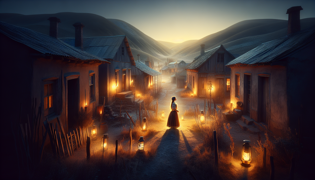
About Story: Difonta Corea: The Miracle of Maternal Love is a Legend from argentina set in the 19th Century. This Descriptive tale explores themes of Perseverance and is suitable for Adults. It offers Inspirational insights. A miraculous journey of defiance, love, and hope.
Introduction
Under a vast, indigo sky sprinkled with the first pinch of twilight, the remote village of San Miguel in the Argentine pampas whispered secrets of old. Here, where dusty lanes met endless fields and time seemed to sway like the winds over the grasses, lived Difonta Corea—a woman marked by both sorrow and an unyielding flame of hope. In the humble adobe home on the outskirts of the village, life was simple and harsh. The aroma of woodsmoke and the distant low hum of cattle merged with whispered prayers and folklore passed down through generations. Yet, within this modest setting brewed a tempest of emotions as Difonta received news that would forever alter her destiny.
Her young son, Mateo, once vibrant and full of life, had fallen gravely ill. The local healer’s somber eyes echoed a fate that seemed written in the stars—a destiny ruled by decay and inevitable loss. However, within Difonta burned a defiant spirit, a love so fierce that it dared challenge the natural order. As the shadows grew long and the village gathered under the glow of lanterns this fateful evening, Difonta made a choice that defied both reason and the supernatural decree of death. In the dim light of a modest prayer room adorned with relics of bygone miracles, she vowed not to abandon hope. Her eyes, dark pools of determination, mirrored both the ancient grief and fierce resilience of her lineage. This singular moment, suspended between despair and the promise of a miracle, set the stage for a journey that would traverse not only the boundaries of life and death but also the very essence of maternal sacrifice.
The air vibrated with a mix of trepidation and reverence; the gentle murmur of the wind seemed to carry ancient voices urging her forward. With every heartbeat, Difonta felt the weight of her promise—to challenge the cruelty of fate with unwavering love, even if it meant venturing into realms unknown. Thus, her story, woven into the fabric of Argentine legend, began with a bold step into the mysteries beyond, where faith and the impossible danced together in a delicate, life-affirming embrace.
The Fateful Diagnosis
In the close-knit community of San Miguel, word of Mateo’s ailment spread like a foreboding mist. Difonta Corea had always been known for her resilience, a trait inherited from her ancestors, whose whispered lore often spoke of battles with fate itself. The diagnosis came on an early, cold morning when mists still embraced the village terraces. With Mateo barely clinging to life, pale and shivering under the fragile blanket of hope, the healer—a wizened woman with deep lines on her face—confirmed that the illness was beyond the realm of medicine. It was as if death had already marked the boy with an unerasable signature.
The healer’s continuous recitations of ancient remedies did little to sway the despair that overwhelmed Difonta. In the gloom of that slow, creeping dawn, Difonta’s resolve crystallized. She recalled the old legends: stories passed down in hushed tones around flickering fire pits, where heroes challenged supernatural forces and defied insurmountable odds through purity of heart and unwavering belief. Here lay her calling. Disregarding the murmurs of inevitability from the villagers, she dove into ancient manuscripts in a crumbling family archive and sought out spells and incantations that had long been buried by time. Every faded page spoke of sacrifices made in the name of life, of prayers that altered destiny.
As the day unfolded, every moment was a battle between sorrow and hope. Difonta spent tireless hours at Mateo’s bedside, whispering affectionate lullabies and promising a future filled with laughter and the aroma of sun-warmed earth. With calloused hands and a heart arrested between faith and despair, she prepared for a journey not just into illness but into the mystical realm beyond mortal comprehension. Her internal dialogue was a cacophony of memories and new-found determination, as she recounted days when her own mother had defied hardships with an almost divine commitment to family.
The village, steeped in a blend of superstition and deep-rooted traditions, watched in awe and trepidation as Difonta sought answers in the old ways. Rumors began to swirl: some said she had discovered a ritual that could negotiate with death itself, while others murmured that her resolve had summoned ancient forces to rally to her aid. Amid these uncertainties, the woman’s solitary figure against the backdrop of an awakening sky painted a portrait of a warrior mother stepping into a realm where mistakes were not an option.
Night descended like a velvet shroud, and in its embrace, Difonta sat before an ancient altar in the modest home she shared with Mateo. With trembling fingers, she arranged relics of her lineage—a faded photograph, a handwoven shawl, and a locket containing the ashes of her late father. In the quiet of that sanctified space, her whispered prayers merged with the nocturnal symphony of distant coyotes and rustling leaves. Each word was a plea, each heartbeat a defiant rhythm against fate. This nocturnal vigil marked the beginning of her journey—a battle where love would be her only shield and hope, her only weapon against the relentless specter of death.
As the first rays of dawn pierced through the narrow window, Difonta’s eyes gleamed with steadfast determination. Despite the grim prognosis, a subtle, almost imperceptible change had begun: Mateo’s pallor seemed to soften, as if the very air itself had decided to stand in protest. This flicker of hope, born out of maternal devotion, set the stage for a quest that would challenge not only the laws of nature but the boundaries between life and the ethereal unknown.
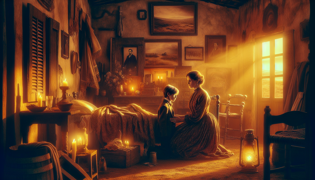
The Journey Beyond Death
Bolstered by the first signs of hope, Difonta made the momentous decision to embark on a journey to seek the aid of a mysterious guardian rumored to traverse the boundaries of life and death. The legend of El Guardián de las Sombras, a spectral figure believed to command the forces of mortality, had been whispered among the elders for generations. They claimed that in times of desperate need, one could approach this enigmatic spirit in a sacred clearing deep within the pampas—a place where the veil between the natural and supernatural thinned exquisitely.
Armed with nothing but a heart full of resolve and a few age-old talismans, Difonta set forth at the break of a crisp, starlit morning. The vast expanses of the Argentine countryside unfolded before her, a rugged tapestry of windswept plains, tangled thickets, and ancient fig trees that seemed to guard secrets of bygone eras. Every step on the winding dirt paths was a silent proclamation against the inevitability of despair. Along her journey, she encountered fellow travelers—some offering words of encouragement while others regarded her quest with wary judgment. Yet, the fire of her purpose never dimmed.
Throughout the day, the shifting light danced over her path. When the sun was at its zenith, the land shimmered under a translucent veil, transforming the ordinary into scenes of almost mystical clarity. Difonta’s eyes, brimming with both determination and tender vulnerability, fixed on the horizon, as if reading the faded maps of fate invisible to all but her. The chorus of nature—whispering corvids, rustling grasses, and the distant lowing of cattle—seemed to blend into a symphony that both comforted and challenged her in equal measure.
Hours melted into an almost meditative silence as she traversed a rugged stretch of land marked by mysterious petroglyphs and ancient stone circles. Each carved symbol seemed to pulse with an otherworldly energy, urging her onward. In moments of solitude under an expansive sky, Difonta recalled the stories of her grandmother, who had once spoken of dreams where ancestors walked among the living and death was not a final destination but a passage. It was in these recollections that she drew an unfathomable strength—a resolve that transcended the physical realm and touched upon the metaphysical.
At long last, as the amber sun began its descent, she reached a secluded clearing encircled by tall, gnarled trees and luminous wildflowers that glowed in the fading light. This was the sacred ground spoken of by the elders—a liminal space where the air carried a palpable charge of both sorrow and promise. She set up a modest camp, arranging offerings of dried herbs, a small crucifix, and a keepsake passed down from her mother. As twilight deepened, the atmosphere shifted; shadows lengthened and danced in rhythmic patterns, casting spectral figures upon the ground.
In the haunting stillness that followed, a figure emerged from the murk of twilight—a being shrouded in drifting mist, its eyes aglow with an ancient wisdom. The guardian’s presence was both awe-inspiring and terrifying. With a voice that resonated like the echo of time itself, the spectral figure spoke not in words but in emotions—a communion of hope, sorrow, and a promise of reprieve. Difonta, undeterred by fear, stepped forward and offered her plea, her voice quivering yet resolute. She recounted the tale of her ailing son, the trials of her people, and her unwavering commitment to defy the ordained path of despair.
That night, under the canopy of a star-pricked sky, in the very heart of the Argentine wilderness, Difonta’s soul became intertwined with forces far beyond mortal ken. The conversation, silent yet profound, exchanged glimmers of fate and threads of destiny. As the spectral guardian slowly receded into the mists of the night, the clearing seemed to shimmer with a promise—a promise that within the labyrinth of life and death, hope and love could carve miracles out of desolation.
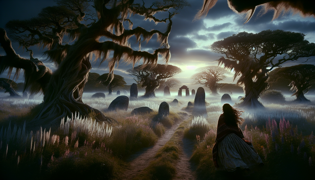
Encounter with the Supernatural
The spectral encounter in the sacred clearing left Difonta with more questions than answers, yet it ignited within her a renewed determination to continue her quest for salvation. In the following days, she experienced phenomena that defied ordinary explanation. As she journeyed back toward her village, the natural world seemed to bend in acknowledgment of her brave foray into the mystical unknown. Subtle manifestations—a shimmering light that guided her at night, unexplained whispers in the rustle of the palm fronds, and delicate water droplets that sparkled unnaturally on dew-laden leaves—became constant companions. Each was perceived not as a mere anecdote but as an affirmation that forces beyond mortal limits had taken notice of her plight.
In one particularly surreal moment, while crossing a narrow, ancient footbridge suspended over a murmuring creek, Difonta was enveloped by an ethereal glow. The light, soft and enveloping, seemed to emanate from the very air around her, casting delicate reflections on the rippling water below. In that transcendent instance, she felt the presence of unseen guardians—ancestral spirits and other benevolent forces from a realm that bridged life and death. They seemed to be urging her forward, offering silent strength.
With each step, the juxtaposition of the natural and supernatural became increasingly intertwined. At sunset, as shadows lengthened over fields of swaying rye and the horizon blazed with hues of scarlet and gold, Difonta encountered a mystic old woman, draped in garments that appeared to be woven from moonlight and ancient memories. The woman, whose eyes held the depth of centuries, introduced herself as Sarita, a custodian of forgotten lore. Sarita spoke of rituals and secret rites that transcended the mere physical realm—of sacrifices and the passage of essences between dimensions. With gentle authority, she guided Difonta through archaic chants and meditative rituals believed to harness cosmic forces to alter fate itself.
Under Sarita’s tutelage, Difonta embarked on a series of rites designed to appease and negotiate with the spectral realm. They gathered rare herbs from the edges of the wild, mixed potent elixirs, and chanted incantations in an old tongue that resonated with the cadence of the land. Each ritual was a delicate dance with destiny—balancing the fragile threads of life while daring to weave a new narrative for Mateo. The air was thick with the scent of burning sage and the palpable energy of ancient incantations, as if every particle of the darkening sky listened in reverence.
In the days that followed, the supernatural elements in the environment grew bolder. Difonta began to dream vivid dreams where time and space melted away, leaving her amidst emerald fields and celestial palaces. These visions were interspersed with moments of intense clarity during which she believed she could see the subtle interplay between life and death. It was in one such dream that she encountered a radiant figure—a young man of otherworldly light—who symbolized hope incarnate. His presence, both consoling and invigorating, reinforced her belief that the threads of fate could indeed be rewritten by a mother’s love.
The amalgamation of these experiences left Difonta with an indelible realization: the supernatural was not an antagonist but a force that could be both callous and benevolent. In the face of terminal despair, the core of existence was stitched together by miracles borne of love, sacrifice, and an unwavering spirit. With each ritual, each ethereal visitation, Difonta felt closer to unlocking the secret that might save her son, even if it meant negotiating with the very forces that governed mortality.
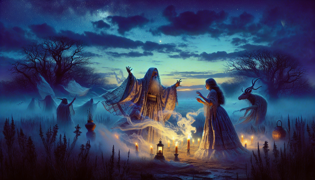
The Final Miracle
After days of relentless pursuit of ancient wisdom and celestial guidance, Difonta returned to San Miguel with an arsenal of mystical knowledge and a heart buoyed by tentative hope. The village, which had watched her departure and heralded her return with bated breath, now became the stage for the ultimate confrontation with fate. Mateo’s condition had worsened in her absence, and as she entered her humble dwelling, the realization struck her like a relentless tide—the battle against death was far from won, but the seeds of a miracle had been sown.
In the quiet solitude of the moonlit night, Difonta prepared for the final ritual. Within the modest confines of her home, transformed for these sacred proceedings, every object radiated significance. The altar was meticulously arranged with offerings that symbolized both the past and the promise of the future: a family heirloom passed down through generations, a vial of water drawn from a revered mountain spring, and carefully selected herbs that carried the scent of autumn and renewal. As the village slept under a blanket of silvered stars, Difonta invoked the spirits of her ancestors. Each whispered chant and every measured step within the ritual was an assertion that love, in its purest form, had the power to defy the very laws of mortality.
The atmosphere thickened with anticipation. As she began the incantation, a strange radiance filled the room. The interplay of candlelight and the supernatural glow of the talismans created an ambiance where time seemed to both stand still and rush forward all at once. In that fleeting, almost mystical moment, the boundaries between life and the afterlife blurred. Difonta’s voice rose in a crescendo, echoing off the bare walls as if the entire universe were listening. Outside, the winds carried her invocations into the vast expanse of the pampas, mingling with the rustling grasses and the silent whispers of lost souls.
It was as though the heavens themselves had conspired to grant her petition. Gradually, an unearthly warmth seeped into the room. Mateo, who lay motionless on a frayed cot, began to show signs of life. His once gaunt cheeks flushed with a hint of color, and a soft murmur escaped his lips—a sound that resonated like the first note of a long-forgotten lullaby. For Difonta, every heartbeat was a triumph, every small sign of recovery a victory against the relentless march of death. The ritual, an intricate blend of ancient lore and raw, personal longing, had opened a channel between the mortal and the divine.
As the night deepened, the miraculous became undeniable. In a climactic moment of transcendent beauty, Mateo’s eyes fluttered open, reflecting a spark of life and wonder that had been absent for far too long. Difonta, overcome with a flood of emotions, wept tears of gratitude and awe. The room, charged with the energy of a miracle, bore silent witness to the power of a love so fierce it could rewrite destiny.
In the days that followed, the transformation was nothing short of extraordinary. Mateo’s recovery, though gradual, defied the bleak prognoses of many a healer. The villagers, once skeptical, now looked upon Difonta with reverence and newfound hope. Her journey had not only defied the natural order but had also rekindled a sense of unity and faith within the community. Her story, whispered from one generation to the next, became a living testament to the enduring spirit of maternal love—a beacon to all who believed that even in the face of death, miracles are possible.
As the Argentine sun rose over the rejuvenated village, Difonta stood sentinel at Mateo's side. In that quiet moment, the scars of loss were softened by the radiant promise of new beginnings. Her ordeal had exacted its toll, yet the triumph of life had prevailed. In the gentle glow of morning, the legend of Difonta Corea was sealed—a story of courage, mystical intervention, and a mother’s boundless capacity to defy the impossible.
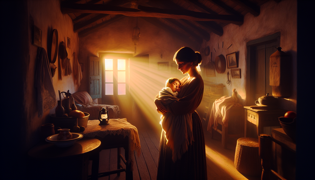
Conclusion
As the days passed in San Miguel, the legacy of Difonta Corea transcended the boundaries of a single miraculous event to become a narrative woven into the very fabric of the community’s identity. The recovery of young Mateo, once deemed fated for demise, spurred not only personal rejoicing but also a collective reawakening of ancient beliefs and the appreciation of life’s fragile beauty. Villagers gathered in the town square to retell the saga of the warrior mother, whose unyielding love challenged nature’s final decree. Her journey—an intricate blend of folklore, mysticism, and raw emotion—served as a timeless reminder that the human spirit, when armed with determination and love, can transcend even the most insurmountable obstacles.
In the quiet aftermath of her ordeal, Difonta found a renewed connection with the past. Visiting the old family archive, she meticulously documented every step of her journey—from the despairing diagnosis to the ethereal encounters in sacred clearings and the culminating ritual that defied death. This written testament became a cherished heirloom, destined to inspire future generations to stand steadfast in the face of adversity. The story of Difonta Corea was not merely a personal chronicle but a mirror reflecting the collective resilience of a community bound by shared hardships and the power of hope.
Quiet reflection and daily acts of gratitude gradually healed the scars that such moments of near-tragedy had inflicted on the village. Fields once somber with loss now bloomed with a vibrant promise, much like the renewed spirit of Mateo, whose bright eyes and lively disposition were living testaments to the miracle he had received. Difonta, ever humble, continued to live with a heart full of both sorrow and joy, her experiences a gentle guide for others who faced similar shadows.
In the interplay of light and shadow that defined her life, Difonta emerged as a beacon of resilience and love. Her miraculous act of defiance did more than just save a life—it redefined what was possible and rekindled an ancient belief that even in the darkest moments, miracles can be born. As San Miguel bathed in the golden hues of a new day, the tale of Difonta Corea continued to echo through valleys and over hills, a hymn of hope that resonated deeply within every soul. The miraculous, it seemed, was not a relic of the past but a living presence, nurtured by every act of courage, every sacrifice made in the name of love.
Thus, the legend of Difonta Corea endures—a stirring reminder that sometimes, against all odds and defiant of death itself, love has the innate power to heal, transform, and inspire. In the shared heartbeats of a humble village and in the whispered memories of ancient lore, her story remains eternal, a guiding light for all who dare to challenge the inevitable with the strength of an unwavering heart.

















